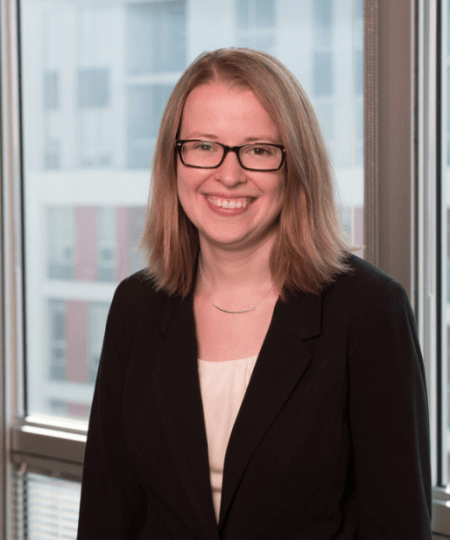Lidiya Mishchenko, S.M. '09, Ph.D. '12
Lidiya Mishchenko learned quite a lot from her applied physics Ph.D. advisor at the Harvard John A. Paulson School of Engineering and Applied Sciences (SEAS). Mishchenko worked in the lab of Joanna Aizenberg, Amy Smith Berylson Professor of Materials Science and Professor of Chemistry & Chemical Biology, researching optical structures and water-repellent surfaces. Aizenberg was a newcomer to SEAS at the time, having arrived with nearly a decade of experience commercializing technology at Bell Labs. Her advisor’s translational background meant that even as Mishchenko pursued her studies, spin-off companies or products were always in the back of her mind.
“We were always considering whether something needs to be written up as a patent,” said Mishchenko, S.M. '09, Ph.D. '12. “Joanna’s focus on commercialization opened up this whole other world that I found fascinating.”
That experience of patenting breakthroughs in the Aizenberg Lab proved foundational to the career path Mishcehnko has taken over the last decade. She worked as an Early Commercialization Assessment Fellow at the Harvard Office of Technology Development (OTD) in her final year in Aizenberg’s lab, and after graduation became a technology specialist at WilmerHale, a law firm that works with OTD.
Mishchenko went on to earn a J.D. from George Washington University in 2016 and clerked for both the U.S. District Court for the Eastern District of New York and U.S. Courts of Appeals for the Federal Circuit, which is responsible for all patent litigation at the appellate level. She recently finished her third year as a visiting assistant professor of law at Duke University.
“The idea of patent law is to try to promote scientists and discovery and come up with an incentive for getting people to share their ideas with the world,” she said. “Having a technical background really works well with my interest in patent law. It’s still focused on advancement in science.”
Born in Uzbekistan, Mishchenko and her family immigrated to Maryland when she was 9 years old. She received her undergraduate degree in physics from the University of Maryland-Baltimore County, doing two undergraduate summer research internships at laser and quantum optics labs.
“I originally was going to major in math, but then I talked to a physics professor during student orientation week,” Mishchenko said. “He told me all the cool stuff is in physics, all the interesting applications of physics, so he sold me on that. It was a really great choice, because the program was small, I got a lot of contact with professors, and I got to know all the students.”
Harvard’s interdisciplinary approach to education sold Mishechenko on the Ph.D. program here. She was part of the award-winning research team for the “Watermark Ink” device, which could identify unknown liquids based on surface tension, and also helped engineer water-repellant nanostructured materials that could prevent icing on power lines, airplane wings or even roads and highways. Going through the patent process for products like those eventually got Mishchenko interested in patent law.
“I met not just people in the OTD, but also external counsel that we used to write up some of our ideas into patent form,” she said. “I thought it was amazing, because these lawyers got to experience so many different technologies and work with so many scientists to commercialize their inventions.”
Mishchenko worked in private law practices after Harvard, but quickly realized she could only go so far without a law degree. Once she had it, it only took two years to become a law clerk in the U.S. District Court, and another year to become a clerk for Judge Timothy Dyk in the U.S. Court of Appeals for the Federal Circuit.
“It was a spectacular experience, because you get to see so many different cases, some of which ended up going all the way to the Supreme Court,” she said. “You really learn what the cutting-edge issues are, what kinds of things frustrate judges more than others, and where areas for reform need to be. My judge has been on the bench for so long and is so experienced, and having conversations with him was amazing. He would have this ‘hot bench,’ as he called it, where he’d practice oral arguments and we had to defend one side of a case. It was a wonderful experience to see his thinking process, figure out what about the case bothered him, and try to figure out how to defend it.”
Mishchenko left the Court of Appeals for Duke in 2021 and has been teaching there for the last two years. She credited Harvard for her return to academia, as she missed the collaborative environment of the classroom.
“I love the autonomy to work on things and focus on long term projects,” she said. “That stayed with me, as well as the love of publishing, sharing ideas and working with colleagues. There’s a structure and rules for practicing law, which I found challenging. But what’s harder to learn quickly are the things you get out of a Ph.D., like trying to break a complex problem down into workable pieces, learning how to talk to professors, or figuring out what’s innovative about your work.”
Working with students again also gives Mishchenko the chance to take a decade’s worth of experience working in the field and pass it onto her students – just like Aizenberg once did for her.
“You need to be thinking more broadly when you’re writing a patent, and make sure you read what the lawyers have prepared and it makes sense to you,” she said. “Patent law is becoming less flexible about what a patent document means. If you really want to protect an invention, you have to think about all the different ways it could be altered in the future and have the core idea still be yours.”
Press Contact
Matt Goisman | mgoisman@g.harvard.edu
